Patriotic Paper
|
In the world of ephemera, cross-collectibility abounds. One of the hottest collecting trends to surface in the last quarter century is the collecting of photographs, first becoming an accepted art form in the late 1970s. Derived originally from a small field of interest encompassing collectors of illustrated books and prints, photography collectors have grown to become a flourishing mainstream market.
In 1979, the art world was shocked and records were shattered when Margaret Weston paid what was then the unfathomable sum of $10,000 for a single iconic image of a seashell taken in 1927 by photographer Edward Weston. Just 28 years later, the record price for a single photograph is held by an Edward Steichen landscape photo sold at Sotheby's last year for $2,928,000.
The May 3, 2007 issue of The Wall Street Journal reported that three major photography auction houses realized the following revenues from photography sales held in the month of April, 2007 alone:
Sotheby's - $15,915,500
Photography has risen rapidly from the bottom of the art chain to claim its spot as the new darling of the art world.
Combine this relatively recent interest and explosive growth in photograph collecting with the long established hobby of postcard collecting - formally known as deltiology - and you can begin to understand the soaring popularity of real photo postcards.
Real photo postcards, also known as RPPC, are a very specific type of picture postcard. Whereas most of the postcards commonly encountered in old albums and dusty attics are mass-produced printed images, real photo postcards are different because they are true photographs produced chemically from negatives onto photographic paper. Other than the postal markings on the back of the images and the standard postcard sizing of 5 ˝" x 3 ˝", real photo postcards are real photographs with postcard backs, produced in limited quantities and providing a remarkable view of ordinary life in the early years of the 20th century.
For this reason, photograph collectors - collectors who have no interest in postcards, per se - have come to notice and appreciate the real photo postcard and embrace its photographic form as one of their own. Prices have risen astronomically as well-heeled photo collectors now regularly frequent postcard shows, asking specifically for examples of real photo postcards to add to their photography collections.
At the same time, long established postcard collectors and dealers are casting a more appreciative eye toward the once-lowly genre of real photo cards, which formerly were relegated to the "cheap" boxes in comparison to the beautifully chromolithographed printed postcards that traditionally commanded the highest prices.
The domino effect that photograph collecting has triggered in the desirability of real photo postcards has rocked the sphere of the postcard world. Real photo postcards were produced in very limited quantities, enhancing their current collectibility. Many real photo postcards are truly one-of-a-kind snapshots, capturing a fleeting moment in time with authentic simplicity through the medium of black-and-white film.
In 1907, new postal regulations permitted messages to be written on the back side of picture postcards and sent anywhere in the United States for the cost of only a penny in postage. Postcards were sent through the mail as often as several times per day, soon becoming the early 20th century equivalent of today's prevalent text messaging.
Responding to the postcard craze that was sweeping the country, Kodak introduced an affordable and easy to use camera that printed photographs directly onto thick postcard stock paper. This technological innovation inspired a flurry of amateur photo postcards taken by non-professional photographers. While local photographers specialized in real photos of town views and printed perhaps several dozen copies of small town street scenes, buildings and special events to be sold in stores, the majority of real photo postcards were produced by ordinary people recording scenes of everyday life with the ubiquitous camera. These vernacular photos capture images which evoke an idiosyncratic charm often found lacking in the professionally staged studio shots.
Okay, so you're now sufficiently motivated to start digging through that old box in the attic for the postcard album kept by Great-Grandma. Not to burst your bubble, but be aware that out of any random untouched postcard album, less than 5% of the postcards may turn out to be real photo cards. How do you spot one?
First of all, nearly all real photo postcards are black-and-white photos. If you use a magnifying glass and see lots of tiny dots on the surface of the picture, the postcard is a printed card and not a real photo. If the photo is captioned (many are not), real photo postcards will often have captions that look handwritten. The caption may consist of all white lettering, which means it was written directly onto the negative. Captions on printed cards look professional and do not appear to be handwritten.
Next, check the address side of the card. Real photo postcards usually have the brand name of the photo paper manufacturer printed directly on the stamp box. Some examples of brand names to look for: AZO, CYKO, VELOX, ARTURO, KRUXO or DEFENDER. If the postcard has been postally used and the stamp box is covered with a postage stamp, look for the words POST CARD on the back of the card in block lettering that appears to be rubber-stamped. Another clue to a real photo card is the stamped name of a photographer or photograph studio on the back side of the card. However, most of the amateur real photos do not bear a photographer's name, and even many photographers who sold their cards for a living did not label their work.
A little experience in handling real photo cards will go a long way toward learning to easily recognize one.
Out of the less than 5% of postcards in a stash which may turn out to be real photo cards versus printed postcards, perhaps less than 5% of those will be extremely desirable to photograph collectors.
There are several main groups of real photo postcard collectors. The first and largest group of collectors has an historic or genealogical interest in a specific place, and they are searching for photographic view cards of buildings, streets and scenes of life as it existed in a particular locale many years ago. Find an elusive real photo of their hometown, and you may have a goldmine on your hands.
Yet another group of collectors has a topical interest in a particular subject, such as railroads, transportation, animals, fashion or any of a myriad assortment of topics avidly sought to complete a themed collection. Such collectors will search for any photo card that matches that interest. According to Real Photo Postcard Guide by Robert Bogdan and Todd Weseloh, the top five real photo postcard collecting categories are:
Of the topical collectors, there are a few that collect a particular niche so narrow that it doesn't fit neatly into any of the major topical categories - collectors of hamster photos, for example, or photos of ladies wearing feather plumed hats.
Another group of real photo postcard collectors are the aesthetic collectors. This group is a direct offshoot of photography collectors. They are more interested in the beauty, composition and artistic lighting of a photo than in the subject it conveys. Any aesthetically pleasing photograph will be fodder for their collections. This type of collector is primarily interested in and appreciative of photography as an art form, rather than a means of historical documentation.
Finally, there is a small group of real photo postcard collectors who collect the work of specific photographers, usually regional photographers who worked and plied their trade within a limited geographic area.
Real photo postcards are HOT, and postcard dealers are reacting by pricing accordingly and, at the same time, realizing prices never even imagined just a few short decades ago.
As in bookselling, recognition of current trends and flashpoints in real photo postcards is necessary to maximize your profits when listing a real photo postcard for sale on eBay. A particular sub-genre of real photo postcards that is enjoying escalating prices on eBay, as well as at conventional auction houses dealing in postcards and ephemera, are real photo postcards with patriotic themes.
According to Real Photo Postcard Guide, "Patriotic refers to cards that show symbols of love of country, mainly American flags draped over people, stores, floats, what have you. It is an amorphous category. Many cards in this category cross over into other categories, such as parades, celebrations, Main Streets, and the military ... The height of photo postcard popularity stretched across World War I, so many of the patriotic images show a citizenry mobilized for war…
"Other American symbols on display in these patriotic cards include Uncle Sam, fireworks, the American eagle, and various images of past patriots such as George Washington. Many of the images are so overembellished with symbolism that, according to present standards, they look silly. That aspect is part of their charm."
Here is an example of a real photo postcard so "overembellished with symbolism" that there are not one, but two, Uncle Sams present in the photo!
The photographer marked the postcard "Flower Parade Wichita 190," giving us a helpful clue to the date. In his handwritten captioning on the negative, he erred and wasn't able to fit the full date within the margin of the photo; however, someone helpfully wrote 1909 in ink on the surface of the card, solving the mystery of when the photo was taken. The horse drawn float displays signage reading "Kansas," which tells us that the photo captures a scene of patriotism in Wichita, Kansas in 1909 - most likely, a Fourth of July parade.
Here is another elaborate parade float with Uncle Sam astride an extravagant swan while holding the reins of a swing dangling from the swan's beak on which two small children are riding.
The photographer's handwriting appears as white captioning on the surface of the photo: "The Swan Resting, York, Neb. 7-14-10, Won 3rd Prise [sic], Grand Auto Parade." The photo was apparently processed quickly by a local photographer and offered for sale within days. It is postmarked July 9, 1910 from York, Nebraska. The sender's message on the back reads in part, "Dear Mother & All, I will send you a picture of one of the Autoes [sic] that were in the parade on the fourth, had a big crowd and lots a doing."
Uncle Sam isn't always riding on floats in these charming patriotic real photo cards. He can also be found on horseback with Lady Liberty alongside.
Sometimes, Uncle Sam takes on the guise of a child dressed in appropriate patriotic costume.
Other patriotic real photo postcards depict people displaying the American flag, such as this scene of an adolescent in costume posing with an oversize flag.
The display of patriotism can be simple and heartfelt.
Here is a swimmer who found an unusual way to display his American pride.
In the waning days of the Old West, men enjoyed dressing as cowboys in photographers' studios, with a huge backdrop of the American flag.
All of the above images fall within the category of patriotic real photo postcards and are extremely desirable. However, many of the cards are cross-collectible and would appeal equally to other topical collectors.
In selling any real photo postcard on eBay, be sure to examine every detail within the photo. You may inadvertently discover another flashpoint that would help sell the card.
Point out any flashpoint that may appeal to a potential buyer. If a photograph displays multiple aspects of interest, its cross-collectibility will inspire two different sets of collectors to vie for it, thus pushing up the demand and ultimate value of the postcard.
For example, the real photo postcard of the swan float depicts a detail that is not readily apparent on first glance. If you look carefully at the storefront behind the float, you will notice an all-seeing eye painted on the window glass.
The mystical all-seeing eye is a symbol of Freemasonry. The partial wording of "Nose and Throat" can be read under the eye,and one can assume that the full signage reads, "Ear, Nose and Throat," advertising a doctor's services. The all-seeing eye above the words implies that the doctor is advertising his status as a Freemason to solicit business from fellow Masons.
Although the postcard's value appears to lie predominantly in its patriotic theme, this little detail of Masonic imagery can be used in a listing description to interest yet another set of potential bidders - those who actively collect historical artifacts of Freemasonry. When you discover multiple facets of cross-collectibility in a real photo postcard, you should use each one as a flashpoint to attract varied sets of collectors to your photo. This will result in a greater demand and a higher final value.
What prices do real photo postcards with patriotic themes bring on eBay? In the month of June, 2007, the following were realized:
A real photo postcard of a pet guinea pig posed on a table with draped U.S. American flags as a backdrop, no identification, circa 1908-1915, un-mailed, with significant crease on lower right corner - $37.99.
A 1909 real photo exaggeration postcard - an exaggeration card consists of two or more real photos combined and superimposed on a photo background to make a single card - captioned "A Kansas Air Ship," depicting what appears to be a giant grasshopper flying through the air carrying a basket with a human passenger and a large American flag, postmarked from Emporia, Kansas - $67.67.
A real photo postcard of a little girl with an American flag draped over her shoulder posing as the Statue of Liberty, circa 1910 - $129.39.
(Photo used with permission, courtesy of eBay seller: medwards.)
As you celebrate this Fourth of July, be sure to remember the patriotism of your ancestors whose love of country was so well expressed and charmingly captured in these real photo postcards of the past.
Copyright 2003-2011 by BookThink LLC
Christie's - $11,176,200
Phillips de Pury & Co. - $10,412,365
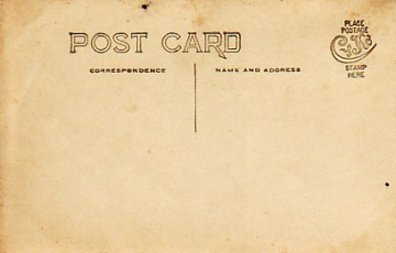
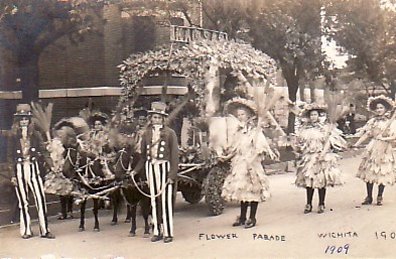
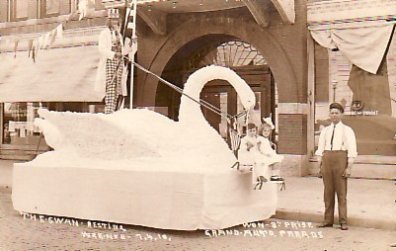
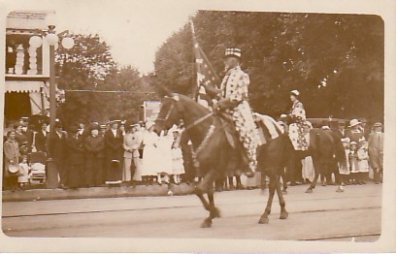
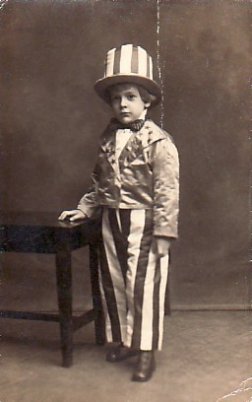
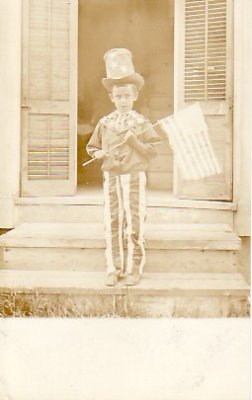
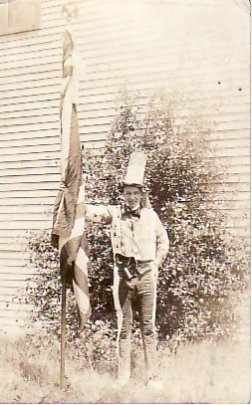
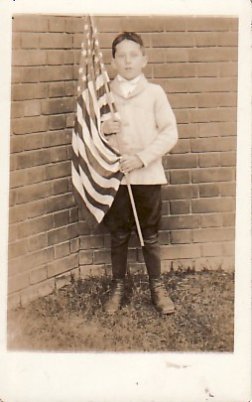
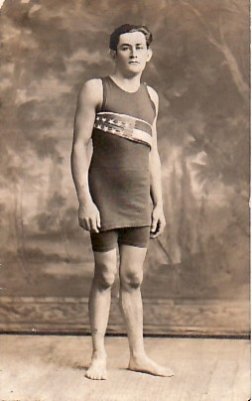
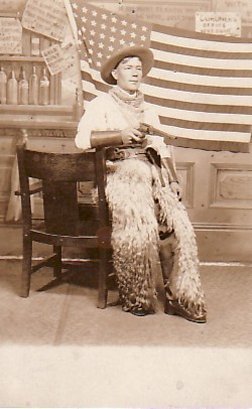
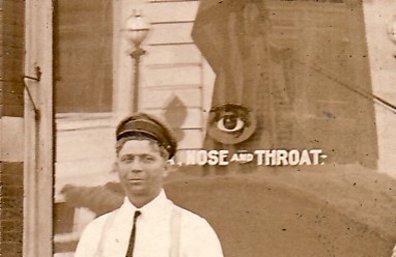
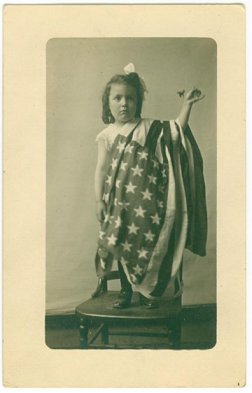 s
s
Contact the editor, Craig Stark
editor@bookthink.com